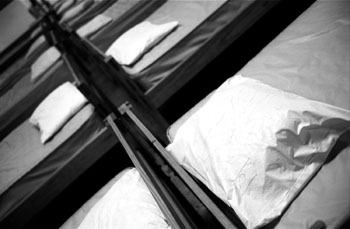![[Metroactive News&Issues]](/gifs/news468.gif)
[ Silicon Valley | Metroactive Home | Archives ]
 Photograph by Paul Meyers Close Quarters: On a daily basis 250 beds are filled by homeless people at the Emergency Housing Consortium in San Jose. Lowering the Roof Homeless advocates expect cuts to emergency housing By Allie Gottlieb There are plenty of reasons to be homeless, according to the governor's recent report on homelessness. After all, 361,000 Californians do it every day in Cali. Good excuses include being crazy, high, poor, behavioral outcasts, opposed to work, unable to work or unable to squeeze housing, utilities, child care and food out of a puny paycheck. Likewise, the governor's May budget proposal reflects this individuality in its housing program cuts. The state's top elected official wants to take $2 million from emergency housing, $1.4 million from child-care loans, $3.6 million from farmworkers, nearly $50 million from a job and housing grant program and $45 million from an affordable-housing project fund. That's not all. Davis recommends chopping $3 million from a downtown loan project, $400,000 from a housing policy review and $300,000 from community-affairs programs. Other social service and mental health cuts could affect homeless programs as well. But the housing cuts aren't the deepest ones Davis suggests. And what do they really mean anyway, since this budget's only a proposal? That's exactly what emergency-housing workers don't know yet. What they do know is that housing needs are increasing, and any cuts are bad. While these aren't the biggest reductions in this budget version, all the slicing is enough to worry local housing agencies. "I can't tell you X will be cut," says Maria Glymph, Emergency Housing Consortium communications manager. "Funding comes from so many sources. Because of the economy, the funding levels are decreasing. That trickles down, and more people are winding up without housing. And that drives up the need." The governor's revised budget proposal is telling because it outlines his funding hierarchy. "Make preventing and reducing homelessness a state priority." That was the top recommendation of the above-mentioned homelessness report, which was presented to the governor in March. Also, in April, Davis signed an executive order directing the state government to prioritize addressing homelessness. Still, housing the poor didn't make the list of four budget categories presented under the bolded heading "Governor's Priorities." Luckily for those 361,000 homeless Californians, housing the poor is a priority for some agencies. The Emergency Housing Consortium runs several programs for the poor and homeless, including the Boccardo Reception Center, a homeless shelter in San Jose. Despite the governor's purported devotion to the homeless, Boccardo (one of the county's estimated 20 shelters) runs mostly without state money. Federal grants provide 57 percent of Boccardo's roughly $700,000 budget, the county funds 26 percent, 7 percent comes from the city and 10 percent comes from private donations. The state does give money to the county, which the county then distributes to homeless service providers like Boccardo. "The county, as opposed to the city [and state], has the prime responsibility for taking care of people who can't take care of themselves," says Joe Zenk, Santa Clara County Office of Homeless Concerns associate. The county gave the shelter about $340,000 last year for its winter program. In the winter, the center provides 250 beds. That number drops by half in the spring and summer. EHC wants to keep those beds available year-round but can't without more money. Zenk predicts that county money for the shelter will remain intact this year. But emergency-housing providers will feel the state's cuts. Zenk expects that the state's contribution to the county for emergency housing (Boccardo generally applies for and receives $50,000 of these county-administered state funds) will be reduced by at least a third. That means more competition between agencies like Boccardo for fewer dollars. Without any budget cuts, the need for housing already outweighs the shelter's capacity. "We try not to turn people away," says Linda Jones, the center's manager. "Sometimes seven or eight people a night are turned away." Others make it into Boccardo and apparently have trouble getting out. Take Erik Bower, a 28-year-old former meth addict and currently unemployed mechanic who says he sends out dozens of job applications a day. He's at eight months and counting. "I feel pretty comfortable here," Bower says. "That's why I've stayed for so long." Bower, who spent four years in the military, says he doesn't mind sacrificing his privacy. He stays in one of the seemingly child-sized single beds packed side by side in the center's giant, dark, depressing, scantily decorated room for single people. "I'd much rather be here than on the streets," Bower says. Ultimately, homeless advocate Barry Del Buono, head of EHC, supports the governor. Interestingly, his argument in support of the budget proposal is based not on Davis' leadership. Rather, Del Buono says Davis is doing more for the homeless than the state has done in the past merely by supporting state Sen. John Burton's $2.1 billion housing bond slated to come before voters on the November ballot. "In fact," Del Buono says, "this housing bond is the first significant money in years that homeless providers can use to help the homeless, I would say." Del Buono expects the bond to pass. Still, it's perhaps coincidental that registering to vote (say, for governor) requires an address.
Send a letter to the editor about this story via email . [ Silicon Valley | Metroactive Home | Archives ]
|
From the May 30-June 5, 2002 issue of Metro, Silicon Valley's Weekly Newspaper.
Copyright © Metro Publishing Inc. Metroactive is affiliated with the Boulevards Network.
For more information about the San Jose/Silicon Valley area, visit sanjose.com.